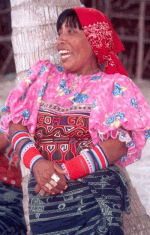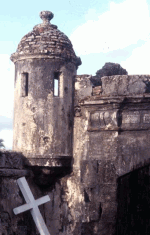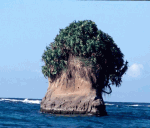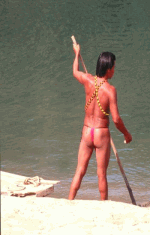written and photographed by Mary L. Peachin
Nov 2002, Vol. 7 No. 2
 Exactly at midnight, Lindblad Expeditions’s 175-foot M.V Sea Voyager untied its lines from dockside Colon, Panama for a 1200-mile, two-week educational and fun-filled cruise odyssey of the Caribbean. The journey began on a southerly course toward the San Blas Comarca (archipelago), before the ship would head north following the Mosquito Coast. Each day we stopped at remote off the beaten path destinations in Panama, Costa Rica, Nicaragua, Honduras, and Belize. This was an active trip: no lounging in a spa or playing casino games. Our evening hours were spent listening to brief educational lectures and watching a video recap highlighting the daily activities: kayaking, snorkeling, scuba diving, bird watching, or a visit to a village or national park.
Exactly at midnight, Lindblad Expeditions’s 175-foot M.V Sea Voyager untied its lines from dockside Colon, Panama for a 1200-mile, two-week educational and fun-filled cruise odyssey of the Caribbean. The journey began on a southerly course toward the San Blas Comarca (archipelago), before the ship would head north following the Mosquito Coast. Each day we stopped at remote off the beaten path destinations in Panama, Costa Rica, Nicaragua, Honduras, and Belize. This was an active trip: no lounging in a spa or playing casino games. Our evening hours were spent listening to brief educational lectures and watching a video recap highlighting the daily activities: kayaking, snorkeling, scuba diving, bird watching, or a visit to a village or national park.
 The intimate group of twenty passengers occupied only two-thirds of a total of 33 renovated cabins. Each room had a full-size window, two beds, and a private bath. Other ship amenities included a glass enclosed lounge, topside observation deck, small fitness center, library, and dining room. Captain Luis Alcocer directed a ship crew of 20. But it was the four expedition leaders, whose expertise ranged from the environment, nature, diving, birding, history, and biology, which made the journey so special.
The intimate group of twenty passengers occupied only two-thirds of a total of 33 renovated cabins. Each room had a full-size window, two beds, and a private bath. Other ship amenities included a glass enclosed lounge, topside observation deck, small fitness center, library, and dining room. Captain Luis Alcocer directed a ship crew of 20. But it was the four expedition leaders, whose expertise ranged from the environment, nature, diving, birding, history, and biology, which made the journey so special.
The ship navigated rolling 4-feet seas before arriving at daybreak in San Blas. 32,000 Kuna, thought to have originated in Colombia, inhabit 40 of the 400 small white-sand palm-covered keys.
 The Kuna has created a flourishing artistic economy stitching colorful reverse embroidered appliqued molas. Traditional pieces feature colors in black, red, and orange. According to legend, during the 18th century when the French arrived to build the Panama Canal, they forced the naked body-painted Kuna to wear clothes by supplying them with colorful fabric imported from neighboring Colombia. A fierce and independent people, the Kuna have maintained their individuality, which includes representation in the Panamanian government.
The Kuna has created a flourishing artistic economy stitching colorful reverse embroidered appliqued molas. Traditional pieces feature colors in black, red, and orange. According to legend, during the 18th century when the French arrived to build the Panama Canal, they forced the naked body-painted Kuna to wear clothes by supplying them with colorful fabric imported from neighboring Colombia. A fierce and independent people, the Kuna have maintained their individuality, which includes representation in the Panamanian government.
As the Sea Voyager headed north, our destinations seemed to track the path of Christopher Columbus. In 1502, he discovered the beauty of a natural harbor, which he named Puerto Bello. Today, this quiet fishing village still shows evidence of Portobello’s history of plunder and piracy. Scattered in the lush green hills overlooking the port remain ruins of forts and cannons.
 The history of the city is fascinating. Royal gold bullion, carried by mule from Peru traveling through Panama over the Camino Real before arriving in Portobello, was loaded on ships headed for Europe. Sir Francis Drake twice plundered the port before losing his life there. The “highway of gold” attracted Dutch, French, and English pirates, some even threatened the Spanish Armada. In 1668, Henry Morgan sacked the city, tortured prisoners and took 250,000 silver pieces-of-eight coins. The forts of Santiago, San Geronimo, and San Fernando were fortified in the mid-1700’s, but were never again challenged. Spanish troops departed after Panama declared its independence from Spain in 1821.
The history of the city is fascinating. Royal gold bullion, carried by mule from Peru traveling through Panama over the Camino Real before arriving in Portobello, was loaded on ships headed for Europe. Sir Francis Drake twice plundered the port before losing his life there. The “highway of gold” attracted Dutch, French, and English pirates, some even threatened the Spanish Armada. In 1668, Henry Morgan sacked the city, tortured prisoners and took 250,000 silver pieces-of-eight coins. The forts of Santiago, San Geronimo, and San Fernando were fortified in the mid-1700’s, but were never again challenged. Spanish troops departed after Panama declared its independence from Spain in 1821.
Continuing northward, our odyssey followed the coastline of the Golfo de Mosquitos located between the eastern Caribbean and western Panama. Christopher Columbus discovered the island of Escudo de Veraguas On his fourth and final voyage. A mile from the atoll Guaymís paddled out to the ship in cayucos. Multi-lingual, the Guaymís speak their own dialect, plus Spanish, Gali-Gali, a Creole-type dialect, and with us, they spoke English to invite us to their small island, one seldom visited because of its isolation off the northwest coast of Panama.
 Columbus bypassed Nicaragua’s east coast during his explorations of the Caribbean. The first European to discover the country was Gil González Dávila. While leading an expedition in 1519 from Panama, a Cacique named Nicarao presented Dávila a gift of gold, and allowed his expedition to be baptized in Lake Nicaragua.
Columbus bypassed Nicaragua’s east coast during his explorations of the Caribbean. The first European to discover the country was Gil González Dávila. While leading an expedition in 1519 from Panama, a Cacique named Nicarao presented Dávila a gift of gold, and allowed his expedition to be baptized in Lake Nicaragua.
Charles Darwin, who did most of his environmental studies in the Galapagos, considered Nicaragua a place of great natural history because of the sweet water lakes of Nicaragua and Managua, the country’s 300-mile fissure through the heart of Central American, and its many volcanoes. Concern about the latter was the primary reason for the French not selecting Nicaragua as the site of what is now the Panama Canal.
 Until 1894, the Caribbean slope of the Miskito coast was part of a kingdom populated by Miskitos, Sumus, Ramas, Garífuna, and Creoles from the West Indies. These indigenous people were able to maintain their independence even through the Sandista revolution of the 1980’s.
Until 1894, the Caribbean slope of the Miskito coast was part of a kingdom populated by Miskitos, Sumus, Ramas, Garífuna, and Creoles from the West Indies. These indigenous people were able to maintain their independence even through the Sandista revolution of the 1980’s.
We disembarked from the ship in the heart of Costa Rica’s “banana belt”. The area has been inhabited since the 1500’s by a wide ethnic diversity of blacks, and immigrants from India and China. Historically, the people were called “Tortugeros” (because they came to hunt turtles.) In the 1700’s, Great Britain brought slaves to Costa Rica to build a railroad. Today, the economy of the province of Limon is driven by the exportation of bananas.
Our Honduran adventure began on the southern border. The ruins of Copan, testifies to the dominance of Mayan culture in Honduras’ history. Located only 10-miles south of Guatemala’s border, we docked on the west coast at the Port of Cortes. In order to reach the ruins, we traveled a narrow winding road by bus for 3-1/2 hours.
 We woke at sunrise to find the ship anchored near Punta Sal National Park, now name for Jeanette Kawa, an activist instrumental in protecting the area, for our final day in Honduras. Historically, the rugged coastline is comprised of a large tidal lagoon and the Ulua river estuary used to be a perfect hideout for pirates.
We woke at sunrise to find the ship anchored near Punta Sal National Park, now name for Jeanette Kawa, an activist instrumental in protecting the area, for our final day in Honduras. Historically, the rugged coastline is comprised of a large tidal lagoon and the Ulua river estuary used to be a perfect hideout for pirates.
The northernmost country of Central America, Belize, was formerly a colony of Great Britain. The British were attracted to the country for the purpose of logging rich forests of mahogany. Today, Belize remains protected by the Commonwealth in its not-so-friendly border with Guatemala. The diversity of its population includes Afro-British Creoles, Mayas, Garífunas, and Mennonites.
While the history we learned was absorbed most of us were entranced with the underwater world of the Caribbean, crystal reefs where we snorkeled and scuba dived and kayaked.
Our first expedition into the rainforest was usually by zodiac. The mouth of the Chargoon river has a rich ecosystem of red mangroves. Prop roots, reaching down to the water, thrive in brackish salinity. Moving upstream, the water in the river loses its salinity and the ecosystem becomes a dense rainforest. The river is a bird lover’s paradise. Parrots and Orange-chinned parakeets squawked as they fluttered overhead. Mangrove swallows joined a solitary black hawk. A crocodile slumbered on a tree stump, its open motionless jaw exhibiting sharp fangs. He was a startling welcome to the tropical rainforest.
 Species of furnarids, antshrikes, antwrens, and thrushes flitted through the trees busily eating fruit and insects. There were larger birds like the Greater ani, a member of the cuckoo family, the Collared aracari, a species of Toucan, and the Ring-necked kingfisher. Flame-rumped tanagers, Greater kiskadees hung on branches, while Red-headed crested lineated, Black-cheeked and Crimson-crested woodpeckers pecked at azteca ants crawling along branches of a tall cecropia tree. The forest was a rainbow of color: bright red passion flowers, purple flowering jacaranda trees, and the yellow flowers of the adamanda. There were balsa trees, and fan palms, used to weave Panama hats, pepper plants blooming with yellow flowers, a species of ginger crowned with a white flower. We observed Brown jays, and the little Blue heron. These juvenile herons, for their first two years, are colored white like Egrets.
Species of furnarids, antshrikes, antwrens, and thrushes flitted through the trees busily eating fruit and insects. There were larger birds like the Greater ani, a member of the cuckoo family, the Collared aracari, a species of Toucan, and the Ring-necked kingfisher. Flame-rumped tanagers, Greater kiskadees hung on branches, while Red-headed crested lineated, Black-cheeked and Crimson-crested woodpeckers pecked at azteca ants crawling along branches of a tall cecropia tree. The forest was a rainbow of color: bright red passion flowers, purple flowering jacaranda trees, and the yellow flowers of the adamanda. There were balsa trees, and fan palms, used to weave Panama hats, pepper plants blooming with yellow flowers, a species of ginger crowned with a white flower. We observed Brown jays, and the little Blue heron. These juvenile herons, for their first two years, are colored white like Egrets.
In Costa Rica as we bussed to catch a boat ride down the Astua Canal in Tortugera National Park, Lindblad Expeditions leader, Bud Lehnhausen, stopped so we could observe a brown throated three-toed sloth in a tall cecropia tree. We stop to watch the sloth, covered with algae, descending slowly down the tree. Every week or 10-days, the female sloth will come to the ground to defecate. Beetles, mites, and moths live in her furry coat. Moths use her trip to the ground to lay their eggs. The female sloth lives alone until she comes into esterase. Her coat then turns a bright orange, and she will screech loudly until she attracts a black-coated male for mating. After a 6-month gestation, she will nurse her baby for the same amount of time; then literally booted the infant out of the tree and her care. Before she does this, she will have taught the infant how to travel from tree to tree, and which variety of leaves to eat. Unlike a monkey, if her baby happens to fall off her back, the sloth will not retrieve it. “My friend sleeps with a sloth” naturalist Isabel Salas told us. They make great pets, they don’t move and they coo. Her friend’s pet sloth, found as an orphan in the rainforest, is fed lettuce and spinach, but once was found eating a pot of paella cooking on the stove.
 The three-mile channel runs between the Matina and Pacuari rivers. According to Salas, the large leaves of the forest move upward towards the sunshine in order to photosynthesize. The beauty of the halyconia is in its leaves, its small flowers are unattractive and rarely noticed. Lianas or woody vines grow very slowly, maybe an inch a year, sometimes streaming from 180-foot kapok trees. Epiphytes, orchids and bromeliads, are scattered on the trunks of the trees. Colorful butterflies flutter along the canal, but not the stunning large blue morpho we were looking for. Leaf-cutter ants move much of the bio-mass of the forest, while army ants create a nest of their own bodies.
The three-mile channel runs between the Matina and Pacuari rivers. According to Salas, the large leaves of the forest move upward towards the sunshine in order to photosynthesize. The beauty of the halyconia is in its leaves, its small flowers are unattractive and rarely noticed. Lianas or woody vines grow very slowly, maybe an inch a year, sometimes streaming from 180-foot kapok trees. Epiphytes, orchids and bromeliads, are scattered on the trunks of the trees. Colorful butterflies flutter along the canal, but not the stunning large blue morpho we were looking for. Leaf-cutter ants move much of the bio-mass of the forest, while army ants create a nest of their own bodies.
Salas considers Costa Rica the “biological bridge” of Central America because of its blend of species and huge biodiversity. Nine species of mangroves survive in brackish salt water offering their roots as homes for crustaceans. Mushroom and other fungus recycle the forest.
Camouflaged on the root of a tree was a lizard called the Basilisk. It is commonly referred to as a “Jesus Christ” lizard because it can run 12 feet on top of the water. A troop of Mantled Howler Monkeys with long saddles on their backs slept in a tall cecropia tree. Frightened by the sound of our boat motor, we hear the rustle of their distinct, yet indescribable bark.
 In 1998, Hurricane Mitch destroyed much of the coral reef in Honduras’ Vivarillo Cay. On a sandy spit at the tip of the cay, we discovered a colony of Magnificent Frigate Birds. Sharing their mangrove nesting areas were Masked and Brown Boobies. Fluffy newborn Frigate Birds puffed to thermoregulate their body temperatures. A few males gallantly inflated large red gulars attempting to entice females to mate.
In 1998, Hurricane Mitch destroyed much of the coral reef in Honduras’ Vivarillo Cay. On a sandy spit at the tip of the cay, we discovered a colony of Magnificent Frigate Birds. Sharing their mangrove nesting areas were Masked and Brown Boobies. Fluffy newborn Frigate Birds puffed to thermoregulate their body temperatures. A few males gallantly inflated large red gulars attempting to entice females to mate.
We also traveled by Zodiac to observe bird colonies on the Monkey River in Belize’s Toledo district, the 45-acre island of Half Moon Caye, off the mainland of Caribbean Belize, walked through rainforest in Punta Sal National Park and Cockscomb Basin Wildlife sanctuary in the southeastern Dangriga district of Belize. But our favorite viewing were those of bird colonies perched on small atolls. We made one last stop at Man of War Cay to absorb one last up-close view of hundreds of nesting Magnificent Frigate Birds before heading in to Belize City to catch our departing flights.
Our odyssey had taken us from Dog Cay(Achuatupo), Isla Grande, Portobello, Escudo de Veraguas, Tortugero National Park, Little Corn Island, Vivarillo Cay, Guanaja, Copan, Punta Sal National Park, Utila, the Monkey River, Half Moon Caye, Cockscomb Basin Wildlife sanctuary, to Man of War Cay. None of these places were household names or ordinary destinations you’d travel to on a Caribbean cruise. The destinations were unique and only accessible because our ship was small and we traveled by Zodiac or kayak.
For further information:
Lindblad Expeditions 1-800-EXPEDITION (1-800-397-3348) or 212-765-7740 [email protected] or go to www.expeditions.com
